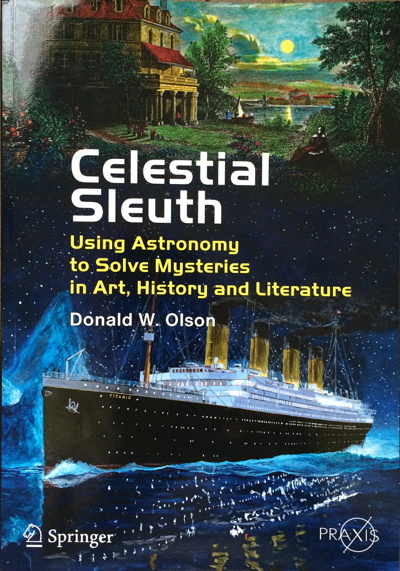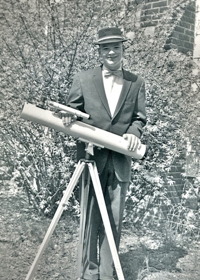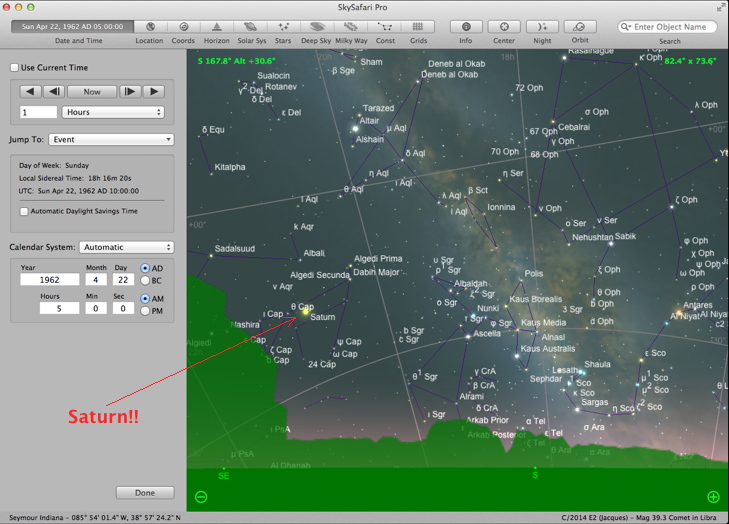Book Review - Celestial Sleuth
Posted: 4 September 2014
 Celestial Sleuth
Celestial Sleuth
by Donald W. Olson
$36.45 (Amazon)
355 pages (including an index)
Published 2014
Sky & Telescope magazine has published several articles since 1987 on "celestial sleuthing" of famous events and paintings. A recent article mentioned this book and I was intrigued enough by the articles I've read to buy the book. The book covers more "projects", as the author describes them, than have been published in the magazine. The book is subtitled "Using Astronomy to Solve Mysteries in Art, History, and Literature".
This is the Table of Contents:
Part I - Astronomy in Art
Monet and Turner, Masters of Sea and Sky
Vincent van Gogh and Starry Skies Over France
Edvard Munch: Mysterious Skies in Norway
Yosemite Moonrises and Moonbows
Part II - Astronomy in History
Moons and Tides in the Battle of Marathon, Paul Revere's
Midnight Ride, and the Sinking of the Titanic
Lincoln, the Civil War, and American Almanacs
The Moon and Tides in World War II
Part III - Astronomy in Literature
Literary Skies Before 1800
Literary Skies After 1800
So what is "celestial sleuthing"? A paragraph at the beginning of Chapter 1 describes it's purpose in the form of questions regarding a famous painting of a stagecoach accident on a snowy road in southeastern France done in 1829 by J.M.W. Turner:
The sky above the mountain includes the Moon and several bright stars or planets. On what date did this stagecoach accident occur? Did Turner paint the Moon in the appropriate lunar phase for that date? Can we identify the celestial bodies near the Moon? Are they stars or planets? Can we verify that Turner's painting gives an accurate portrayal of the celestial scene?
For each of the projects, the author takes you through the necessary research, the onsite investigations, the measurements taken and analyzed, and the astronomical conditions needed to answer the questions posed. The projects read somewhat like a detective novel; the author and his students traveling around the world to get to the scene, contacting local residents, taking measurements at the scene, and checking past records. For many of the projects, calculating positions of various objects in the sky for the site under investigation provide excellent, but not necessarily complete, data to determine dates and specific locations. Diaries, letters, newspaper reports, meteorological observations, and in some cases, very detailed analysis of astronomical objects (i.e., lunar libration conditions) are often used. Each project spans just a few pages, but each captures a story and comes to a specific conclusion.
As you might expect in a "detective yarn", some of the investigations resulted in interesting twists that yielded new insights into what occurred in the past. And sometimes the results from the projects have been cited to correct the historical record of the painting or event.
I was thoroughly fascinated by the first two parts of the book, many with on-scene reports by the author and his students. The first half of Part III was somewhat "dry" (to me), whereas the second half was more exciting (probably due to the subject matter).
Summary
If you have enjoyed reading some of the author's celestial sleuthing articles in Sky & Telescope magazine over the years, you will enjoy this book, which includes more details and more photographs. If you missed some of the articles, this book will fill in the gaps. If you have never read the articles in S&T and you want to go along on scientific investigations into the past, you will want this book. It is almost like "time travel" in that you get to visit far off places at different historical times. I found the book an enjoyable and educational read. You will too.
You can buy the book at Amazon using this URL and support Cassiopeia Observatory. Thanks.
My Own Celestial Sleuthing
After reading the book I decided to try my own "celestial sleuthing".
 I made my first telescopic observation of Saturn with my Edmund Scientific 3" Newtonian telescope, as seen in the photo at the right taken on Easter morning, 1962. My memory says I made the observation earlier that same morning, which was a few months after receiving the telescope as a Christmas present from my mother. I knew that I made the observation from the south end of our front porch in Seymour, Indiana. (The porch is just to my left off-camera in the photo.) The time was probably around 5am and I made the observation looking towards the south-southeast through gaps in the trees along the street. I was so excited by the view that I ran into the house and woke up my mother so that she could come out and see Saturn through my telescope. Although she was barely awake she did come out and was quite pleased with the view. It was her first time too!
I made my first telescopic observation of Saturn with my Edmund Scientific 3" Newtonian telescope, as seen in the photo at the right taken on Easter morning, 1962. My memory says I made the observation earlier that same morning, which was a few months after receiving the telescope as a Christmas present from my mother. I knew that I made the observation from the south end of our front porch in Seymour, Indiana. (The porch is just to my left off-camera in the photo.) The time was probably around 5am and I made the observation looking towards the south-southeast through gaps in the trees along the street. I was so excited by the view that I ran into the house and woke up my mother so that she could come out and see Saturn through my telescope. Although she was barely awake she did come out and was quite pleased with the view. It was her first time too!
Could I do some "celestial sleuthing" to verify my memory of the date and time? I gave it a try using some of the techniques in the book.
First, I needed my home's latitude and longitude. I'm sure I have it somewhere in my papers from that time, but it was easier to get it from the Internet. I used http://www.distancesfrom.com/Latitude-Longitude.aspx to determine the lat/long for my childhood home as 38.956731° N, 85.900377° W. I used the elevation of the local airport (178m) since the terrain is relatively flat in my hometown. Next, I looked up the date for Easter in the years 1962 (22 April), 1963 (14 April), and 1964 (29 March). I used those years as the most likely years I could have made the observation. Then I needed to know if Daylight Saving was a factor. According to information I found online, the time switch occurred on 29 April 1962, 28 April 1963, and 26 April 1964. Indiana has made some changes in how it has handled the time switch over the years and I recall that my home county did not change the clocks in some years; unfortunately I don't recall what years those were. But since the change dates were all after Easter for the years that were mostly likely for my initial observation of Saturn I decided that DST was not in effect on the date of my observation (assuming it really was on an Easter morning).
I set up SkySafari Pro on the Mac for my childhood home location and then changed the date and time to Easter morning, 22 April 1962, 0500 CST. And there is Saturn in the south-southeast!

Would it have been high enough to view? SkySafari Pro said it was 22° in altitude, certainly high enough to see from my porch.
What about Easter morning in 1963? SkySafari put Saturn east of southeast, which would have been difficult to view from the porch due to trees and a house across the street. And Easter morning 1964? Saturn was in the south-southeast but below the horizon at 0500 CST. It would not have risen high enough to view before sunrise that morning.
What about the weather? Was it clear that morning? I tried searching for historical weather data for my hometown but apparently nothing is available online prior to 1973. So, without returning to Indiana or asking the local library to check an old "Seymour Daily Tribune" newpaper for the weather, I can't confirm that it was clear.
Using "celestial sleuthing" I have likely confirmed my memory that my first telescopic observation of Saturn was on Easter morning, 22 April 1962, at approximately 0500 CST, from the porch of my childhood home in Seymour, Indiana.
When will an Easter morning Saturn observation to the south-southeast from my home's porch be possible again? Using SkySafari Pro I was able to determine that on Easter, 12 April 2020, Saturn will be almost in exactly the same location in the sky as it was for my Easter morning observation in 1962. Maybe I'll be able to take my Edmund 3" telescope (which I still have) back to my childhood home (which is still there) and repeat my initial telescopic observation of Saturn. That would be exciting!
After you read "Celestial Sleuth", you will probably want to do some celestial sleuthing of your own. Have fun!
Comments are welcome using Email. If you are on Twitter you can use the button below to tweet this report to your followers. Thanks.
Cassiopeia Observatory Home Page
Copyright ©2014 Michael L. Weasner / mweasner@me.com
URL = http://www.weasner.com/co/Reviews/2014/Celestial_Sleuth/index.html
